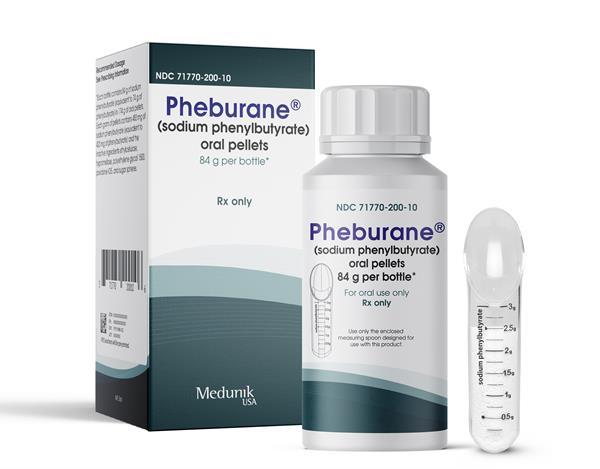Pheburane Dosage
Generic name: SODIUM PHENYLBUTYRATE 483mg in 1g
Dosage form: oral pellet
Drug class: Urea cycle disorder agents
Medically reviewed by Drugs.com. Last updated on Aug 17, 2023.
2.1 Recommended Dosage
PHEBURANE treatment should be supervised by a healthcare provider experienced in the treatment of urea cycle disorders.
The recommended dosage of PHEBURANE (measured as sodium phenylbutyrate) for patients with urea cycle disorders is:
- Patients weighing less than 20kg: 450 – 600 mg/kg/day of sodium phenylbutyrate orally. Divide the calculated total daily dose into three to six doses. Administer as three to six divided doses and take with food.
- Patients weighing greater than or equal to 20 kg: 9.9 – 13 g/m2/day of sodium phenylbutyrate orally. Divide the calculated total daily dose into three to six doses. Administer as three to six divided doses and take with food.
The maximum dosage is 20 grams per day. Combine PHEBURANE with dietary protein restriction and, in some cases, amino acid supplementation (e.g., essential amino acids, arginine, citrulline, and protein-free calorie supplements).
Measure the dose using only the calibrated spoon provided in the packaging. This calibrated dosing spoon directly measures PHEBURANE oral pellets as sodium phenylbutyrate [see Dosage and Administration (2.4)].
If a dose is missed, take the missed dose as soon as possible. There should be at least 3 hours between two doses and doses should not be doubled to make up for the missed dose.
2.2 Dosage Adjustment and Monitoring
Monitor plasma ammonia levels to determine the need for dosage adjustment. Adjust the PHEBURANE dosage to maintain the plasma ammonia level within the normal range for the patient’s age, taking into consideration their clinical condition (e.g., nutritional requirements, protein intake, growth parameters, etc.).
Monitor patients for potential neurotoxicity and obtain measurements of plasma phenylacetate and phenylacetylglutamine levels [see Warnings and Precautions (5.1), Adverse Reactions (6)]. If neurologic symptoms (e.g. vomiting, nausea, headache, somnolence or confusion) are present in the absence of high ammonia levels or other intercurrent illnesses, consider reducing the dose of PHEBURANE.
Dosage Adjustment in Patients with Hepatic Impairment
For patients with hepatic impairment, start at the lower end of the recommended dosing range and maintain patients on the lowest dose necessary to control plasma ammonia levels [see Use in Specific Populations (8.7)].
2.4 Administration Instructions
For oral administration only. Administration via gastrostomy or nasogastric tubes has not been evaluated.
- Schedule PHEBURANE dosages at the same time as food consumption (meal or snack).
- Use the calibrated dosing spoon to measure PHEBURANE oral pellets. The dosing spoon is directly calibrated in grams of sodium phenylbutyrate.
- Swallow the coated oral pellets with a drink (e.g., water, fruit juices, protein-free infant formulas) or sprinkle onto spoonful of apple sauce or carrot puree. Do not chew PHEBURANE oral pellets directly or mix into liquids.
- Swallow immediately to minimize dissolution of coating.
Administration of PHEBURANE oral pellets with other foods has not been studied and is not recommended. Additionally, administration with soft food is only recommended in patients old enough to consume soft foods.
More about Pheburane (sodium phenylbutyrate)
- Check interactions
- Compare alternatives
- Pricing & coupons
- Drug images
- Side effects
- During pregnancy
- Drug class: urea cycle disorder agents
- Breastfeeding
- En español
Patient resources
Other brands
Professional resources
Other brands
Related treatment guides
Further information
Always consult your healthcare provider to ensure the information displayed on this page applies to your personal circumstances.

